Controverscial.Com
![]()
Welcome
![]()
|
Controverscial.Com
Welcome
|
|
|
Controverscial.Com
Welcome
|



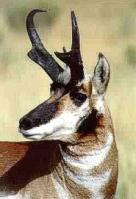
Pronghorn
antelope of America
Antelope is the common name applied to a large group of cloven-footed, hollow-horned mammals belonging to the family (Bovidae), which includes cattle, goats and sheep. The group is made up of about 150 different species, but true antelopes are only found in Africa and Asia.
Antelopes are typically swift, slender and graceful animals that generally have
a short, tough and dense coat of fur, which protects the animal from sharp barbs
as it grazes among brush and thickets. In most species the coat is some
variation of brown with a white or pale under-body. Exceptions include the
zebra-marked Zebra Duiker, the grey, black and white Jentink’s Duiker and the
Black Lechwe. Desert and sub-desert antelope are usually pale, or some
like the Arabian Oryx are silvery white. The Beisa and Southern Oryxes
have gray and black coats with vivid black-and-white faces, while most of the
spiral-horned antelopes have pale vertical stripes on their backs.
In size, antelopes vary in range from the tiny Royal Antelope standing about 25
cm (10 in) high and weighing 1.5 kg (3.3 1b), to the Derby Eland reaching about
1.8 m (6 ft) in height and weighing up to 680 kg (1,500 lb). They can be
found in a wide range of habitats such as wooded-forests, savannahs, grassland
and marshes. Several species have adapted to mountains and rocky outcrops,
and a few others to deserts (both hot and cold), some are even semi-aquatic and
live in swamps.
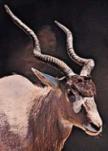
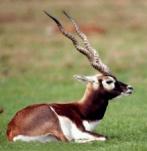
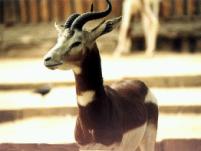
Addax - Blackbuck
- Dama Gazelle
Antelopes
are ruminants and have well-developed molar teeth used to grind cud (i.e.
chewing the cud) into a pulp for further digestion. They have no upper
incisors but rather a hard upper gum pad against which their lower incisors bite
in order to tear grass from the ground and leaves from trees. Using a
complex digestive system, plant food is first swallowed, stored and part
digested before being regurgitated back to the mouth for chewing, then
re-swallowed into the next stomach. Antelopes as well as cattle, goats,
deer and giraffes, all have a four-chambered stomachs. Their digestive
systems also allows them to survive without water for long periods, getting all
the water they need through the plants, shrubs and sagebrush they feed on.
Like many other plant eating animals, antelopes rely on their keen senses to
avoid danger from predators. Their eyes are placed on the sides of their
heads, giving them a broad radius of vision which affords them excellent
eyesight with minimal binocular vision. The fact that most species have
their pupils elongated horizontally also helps in this respect. Acute
senses of smell and hearing give antelopes the ability to perceive danger at
night, even out in the open. Some antelope are solitary but many of the
species travel in herds.
In communicating between others animals of the same species, many antelope
“flash” each other using markings on their heads, ears, legs and tail.
More conspicuous to many antelope is a characteristic white patch on the rump.
When alarmed the hairs of the white patch stand erect, which makes the patch
appear to flash in warning, and can be seen for miles around. In vocal
communication they use a variation of noises, which include: barking,
whistling, mooing and trumpeting. They also use scent to define their
territories or simply to maintain contact with others in their areas.
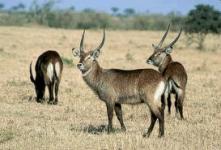
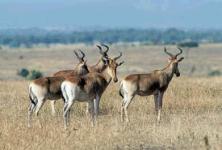
Waterbucks
- Hartebeests
In
many species of antelope both males and females have horns, which are permanent
unlike the annually-shed antlers of deer. Those of the male antelope tend
to be larger, but size and shape of horns vary immensely. Most common
antelope have backward curving or backward pointing horns like the Yellow-backed
Duiker, or straight and upright horns like the Steenbok. Others have
twisted horns (Common Eland), spiral horns (Greater Kudu), “recurved” horns
(Reedbucks), lyrate horns (Impala) or long and curved horns (Oryxes).
Horns are efficient weapons and tend to be better developed in those species
where males fight over females making their horns clash in combat.
Hooves are another common feature among antelope and are adapted among different
species to suit their individual habitats. Each hoof has a split down the
middle, which effectively divides the hoof into two “toes”. Those that
live in the wetlands and swamps of Central Africa like the “sitatungas
antelope”, have wide hooves up to 7 ins (18 cms) across to help them walk on
mud or matted plants without slipping. Similarly the “lechwe” and
“impala” antelopes live in swampy areas of the Nile, and have long pointed
hooves to give them sure footing in the water. The small slender-horned
“gazelle” of the open African plains has sturdy wide hooves so it can walk
on the shifting sand of the desert, while the “klipspringer” antelope of the
rocky north of Ethiopia and Nigeria have tiny rounded hooves with a pad in the
centre that acts like a suction cup enabling them to nimbly hop from rock to
rock without falling.
With the antelope having so many different species it is only possible to
generalise on their life spans and breeding habits, but a common medium sized
antelope tends to breed in August and September, and after a gestation period of
about eight to nine months their young (normally one or sometimes twins) are
born in the following May or June. The young are generally born with
similar markings to the adults, unlike the spotted fawns of the deer family,
after which they are kept hidden and fed by the mother several times a day until
they are strong enough to travel with the rest of the adults.
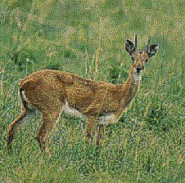
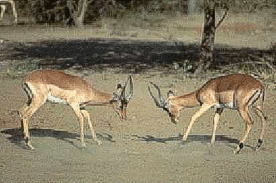
Oribi
- Impala
Depending
on the species, an antelope’s age to maturity can vary from 9 months to 5
years, while their lifespan in the wild is thought to be 6 to 8 years. In
captivity, wildebeest have been known to live beyond 20 years old, and
Impalas have reached their late teens. In the wild however, few animals of
the passive prey species live to an old age, as the old and weak fall prey to
their predators; antelopes are no exception to this rule.
Native to America is the Pronghorn antelope, a mammal belonging to a different
family (Antilocapra americana). Standing about 90 cm (3 feet) at the
shoulder and weighing about 55 kg (120 lbs), the pronghorn is considered to be
the fastest animal in North America with a maximum-recorded speed of 86.5 km/h
(53.8 mph). Both sexes of the pronghorn bear erect horns that branch into
two prongs, the longer curving backward and the shorter projecting forward.
Its coat is generally reddish brown with a dark brown mane, white under-body,
two white bands on its neck and a large white patch on its rump, which when
alarmed stands out producing a white flash in warning.
Pronghorns inhabit the open plains and semi-desert areas of America, where they
feed on grass, sagebrush, cactus and other herbaceous plants. They live
alone or in small bands in the summer and form larger herds in winter. The
male gathers a harem in late summer, and the female bears one or two young fawns
(twins) after a gestation period of about eight months.
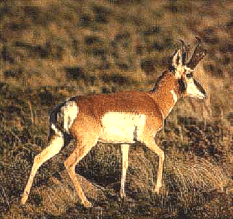
Pronghorn antelope of America
In
the past the pronghorn was widely hunted as a game animal, and during the 1920s
the number of pronghorns left in the wild was thought to be less than 20,000.
Today with better control of hunting and good wildlife management, the
population is back to between 750,000 and 1 million.
Other species of antelope include: Addax; Blackbuck; Blesbok; Duiker;
Gazelle; Gnu; Nilgai; Dik-dik, Gerenuk, Gemsbok, Hartebeest, Impala,
Klipspringer, Greater Kudu, Nyala, Oribi, Arabian Oryx, Grey Rhebok, Roan
Antelope, Royal Antelope, Sable Antelope, Springbok, Suni, Tibetan Antelope,
Topi, Waterbuck and Blue Wildebeest, just to mention a few.
In the folklore of Liberia, the Royal Antelope is a figure renowned for its speed and wisdom. Because of its small size and habits, it was known locally as the “King of the Hares”, and it is from this kingly appellation that the common name “Royal Antelope” was derived.
In
many cultures the horn of an antelope is prized for its medicinal and magical
proporties. The horn of the male
“saiga antelope” for instance, is ground up as an aphrodisiac and was once
threatened near to extinction by demand for its horn in traditional Chinese
medicine. Once a vanishing species,
the saiga antelope is now protected and in 1994 was listed in Appendix II of
CITES requiring a special permit for its trade.
Its total population in 1995 was estimated at about 1 million.
Christian
iconography sometimes uses the antelope’s horns as a symbol representing the
Old Testament and the New Testament. The
antelopes ability to run swiftly has also led to their association with the
wind, such as in the Rig Veda, as the steeds of the Maruts and the wind
god Vayu. In
the Congo the horns of the antelope are thought to contain ancestral spirits.
In African mythology as creatures of grace and speed, the antelope suggests the power and elusiveness of the spirits. They are often seen in the Chi Wara, a headdress or facemask worn by the Bambara of Mali. The Chi Wara antelope mask is made of polished and painted wood, and is worn by members of the Bambara in rituals associated with planting and harvesting. The dance they perform while wearing this mask honours Chi Wara, the Bambara God of agriculture.
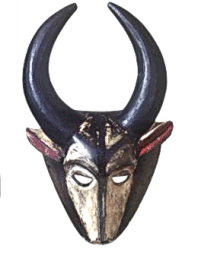
Chi Wara Antelope Mask
Similarly
the Kurumba people of the Nilgiri Hills in southern India
produce a masked headdress
in the form of an antelope. The
powerful neck supports a head with a long pointed protruding snout.
Earlier versions had large ears curving to the towering horns in a
semi-circular fashion (echoing the curve of the chi wara mane of the Bambara).
Early versions of the masks were fashioned with face covering much like
the masks of the neighbouring Dogon people of Mali.
Many of the masks are painted with geometric designs using natural
pigments of white (kaolin), black (river mud or charcoal) and reddish brown
(ochre), while the horns are banded in stripes of the same colours.
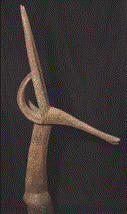
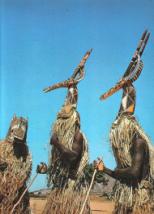
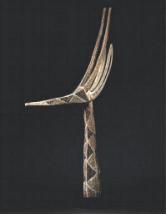
Kurumba
Antelope Mask -
Antelope Dancers -
Decorated Kurumba Mask
The
Kurumba masks are used in three major events during the tribes annual cycle.
In the first instance the masks are worn to escort the corpses of dead
elders to their tombs, and supervise the burial on behalf of the spirits of
their ancestors. Weeks or even months later during the dry season, the masks
are used again to complete the funeral rites by honouring the deceased and
freeing their spirits to travel to the world of their ancestors.
Finally just before the first rains of the season the masks are worn at
collective sacrifices in which the ancestors are honoured together with the
spirit of the protective antelope “Hippotragus koba”, the totem antelope of
most Kurumba tribes.
At
funerals and at public performances, the masks act as the physical re-embodiment
of the spirit of the deceased elder, during which the mask may be addressed
using the dead person’s name. The
mask is a means of preserving the memory of the dead, by providing a physical
reminder of the dead elder’s achievements in life.
In addition a mask carved at the death of a high-ranking elder serves to
enhance the prestige of the deceased. When
not in use the masks are placed on altars in the ancestral spirit house located
within the family compound, on this the living offer sacrifices to the dead and
secure their blessings for the year to come.
The
Antelope and a Frog
The
Kootenai Indian tribes who once
inhabited the area of present-day west-Montana tell a story about an Antelope
and a Frog: “The antelope
was very proud animal, but also very arrogant about his running ability.
One day he boasted to frog about his superior speed over all other
animals. This irritated the frog
who decided to trick the antelope into a race along the creek-bed.
The antelope smugly took up his challenge and bet heavily on winning the
race. Before the race however, frog
called all his relatives and cleverly hid them in the reeds of the creek-bed,
and when the race started they jumped up in sequence just in front of the
speeding antelope. Since each frog
only had to jump once they never got tired, while the antelope soon became
exhausted and was beaten to the finish line.
When the antelope expressed his amazement at the speed of the frog, the
frog confessed and told him it was not so much that he was a faster runner, more
that he was a faster thinker” :-)
The
Antelope and the Deer
In a Tachi Yokut Legend of the Native North American peoples in central California, an antelope and the deer were roaming together around Tulare Lake when the antelope said: “I bet I can beat you running”, “I think not” said the deer “for I can leap and bound as quick as you can run”. The antelope replied: “Well, let us try”, and so the antelope and the deer agreed to run a race.
The deer said: “Let us go to the south of the lake and run northward”. When they arrived they could see that to the west of the lake was open plains, while the east of the lake was covered in patches of brush. The antelope said: “As you boost you can leap and bound as quick as I can run, I will take west side of the lake and you can take the east side”, to which the deer agreed.
As part of the agreement the antelope said: “If I win, all this open country will be mine and you will have to hide forever in the brush”. The deer replied: “Very well then, and if I win it will be the same for you”.
Needless to say the antelope won, for the deer couldn’t complete the race when he leapt into a particularly dense patch of brush and failed to get out. This is why today the antelopes live on the plains while the deer remains hidden in the brush.
The
Golden Antelope
In a folktale from West Java there once was an old and poor man who lived alone in the jungle. His wife had passed away years ago and he did not have any children. He made a humble living by collecting firewood, which he sold in the local village. One day the old man saw a beautiful antelope, but it was different from any other antelope he had ever seen, for the colour of its skin was golden. As the old man walked slowly towards the antelope, he could see that it looked very weak. When he gave the antelope some food it spoke and said: “Oh! Thank you Sir, you are very kind”.
The old man was shocked: “You can talk? Who are you? Are you the ghost of the jungle?” he asked in surprise! “I’m sorry old man, but I cannot tell you who I am, if I do many people will come and hunt me, so please don’t tell anyone about me” replied the antelope. Since the old man had found a new friend in the golden antelope, and someone to talk too, he didn’t feel lonely anymore and promised not to tell a soul.
Sometime later the old man fell ill and couldn’t collect his firewood. “Don’t worry old man, I will collect the wood for you” said the golden antelope. The golden antelope then went out into the jungle to collect the wood, but didn’t realise that some hunters were following. One of the hunters was a handsome young prince called Wijaya. Prince Wijaya loaded an arrow in his bow and fired it at the golden antelope. When the arrow hit the antelope a plume of smoke surrounded its body, but when the smoke dissipated instead of seeing the antelope, a beautiful young girl appeared.
“Oh! Thank you Sir, you have just released me from a curse. I am Princess Sutha. A witch cursed me into a golden antelope and I could only turn back into human if a prince hit me with his arrow” she explained. Later Prince Wijaya asked her to go back to his kingdom with him, but Princess Sutha would only agree is the old man could join them. So they returned to the old man’s house and asked him. The old man was surprised to have a prince and princess visit his home, and was so happy after Princess Sutha explained everything. He then agreed when they asked him to live with them in the palace. Not long after Prince Wijaya and Princess Sutha were married and lived happily ever after.
The
Legend of Unumbotte
The
Bassari tribe in northern Togo, West Africa, worship a creator God called
Unumbotte, who according to legend made all living things:
When Unumbotte came down from the sky he made human beings and named them Man. Unumbotte made an antelope and named it Antelope. Unumbotte made a snake and named it Snake. At the time he made these three there were no trees but one, a palm. Nor had the earth been pounded smooth. One day while all three were sitting on the rough ground Unumbotte said to them: “The earth has not yet been pounded smooth. You must pound the ground smooth where you are sitting”. Unumbotte next gave them seeds of all kinds and said: “Go plant these seeds”. Then Unumbotte went away back into the sky.
When Unumbotte returned from the sky he saw that the three had not yet pounded the earth smooth. They had planted the seeds however, for one of the seeds had sprouted and grown into a tree. It had grown tall and was bearing red fruit. Every seven days Unumbotte would return from the sky and pluck one of the red fruits. One day Snake said: “We too should eat these fruits. Why must we go hungry”? Antelope said: “But we do not know anything about this fruit”. Then Man and his wife took some of the fruit and ate it.
When next Unumbotte came down from the sky he asked: “Who ate the fruit”? They answered: “We did”. Unumbotte asked: “Who told you that you could eat that fruit”? They replied: “Snake did”. Unumbotte asked: “Why did you listen to Snake”? They said: “We were hungry”. Unumbotte then questioned Antelope: “Are you hungry too”? Antelope said: “Yes I get hungry. I like to eat grass”. Since then the Antelope has lived in the wild eating grass.
Unumbotte then gave Man seed to plant sorghum, yams and millet, and thereafter all the people gathered in separate eating groups and eat from the same bowl, never the bowls of the other groups. It was from this that differences in language arose. And ever since then the people have ruled the land. But Unumbotte gave Snake a medicine, with which to bite people :-)
![]()
Contributed by - Patricia Jean Martin
As
totem spirit animals, all horned or antlered animals have a strong connection
to the qualities related to the Brow (or Third Eye) and the Crown Chakras.
Those related to the Brow/Third Eye indicate intuition, insight and
meditation, which clear the subconscious to open the Chakra to knowledge and
intellect. Those related to the Crown are to do with the Higher Self,
Spirit and spiritual connection to the Divine, other ethereal matters and
wisdom.
The antelope has horns similar in some respects to the antlers of deer, however
the horns of the antelope are permanent unlike the annually shed antlers of
deer. This suggests that those with antelope as their Totem are most often
focused on knowledge and wisdom and are incessantly seeking to connect it to
their spiritual examinations. The antelope will ask even further that you
use your mental prowess in additional endeavours, and will ensure that your
quick-witted and keen mental agility will serve you well in all you do.
Seeing any antelope in a totem capacity (be it as a Life Totem or merely a
Messenger Totem) may suggest that you will soon be engaged in increased mental
activity, or it is an acknowledgement that you already have been and will
continue to be engaged in such, but in an even more pronounced and worthy way.
It is also an indication that your own psychic ability is about to increase in
size and scope, and that you will be guided on how to use it in the most
benevolent way. If ever stuck for an answer or for even a new
way of looking at things, calling on antelope will provide the insight,
knowledge and ideas needed to start drawing on that blank page before you.
The antelope can live almost anywhere, and is found in various environments.
They have a very thick hide - thicker than most - and it is used in a protective
capacity in order to be able to endure these different environments. Those
with antelope as a totem may find that they need to develop a thicker skin of
their own, meaning to become less emotionally sensitive and more secure in their
knowledge of self-worth, something which precludes being able to deal well with
adversity of any kind. Or, it may indicate that you already have a thick
skin and can withstand much more than other more sensitive types, and like water
rolling off a duck’s back, not too much will be able to penetrate and bother
you. It is very common for one who is very emotional or very empathic to
have antelope show up to deliver these messages and more.
This thicker hide acts like an insulator. Being insulated, you are better
able to venture outside and come out of hiding. Once out in the open,
antelope can teach you how to communicate with the great wit and wisdom that you
already possess. All antelopes are fast - adults are able to run up to 70
mph or more, and baby fawns can even run up to 25 mph within the first day of
life! This signifies the quick-wittedness and intelligence already there
and just waiting to burst out in communication with others. There will
also be an increase in curiosity...questions, questions, questions... all meant
for further gaining of knowledge that will lead to wisdom. Those with an
antelope totem are prone to have very active imaginations.
Antelopes have large eyes. Their eyesight is excellent (8 times that of a
human’s) and they possess a wide range of vision. When antelope comes
into your life, you will be pushed to widen your own range of vision. With
large eyes (also a signal that clairvoyance will be increased), you may find
your mind and imagination will be in over-drive, constantly seeking out and
enjoying greater and greater thoughts and ideas. The antelope uses this
wider range of vision for both greater insight into what is going on around
them, and for a greater ability to protect themselves. If danger arises,
an antelope will raise the white patch of fur on its rump end as a signal to
others that something is amiss. This shows another side of their survival
instincts and capacity to protect themselves and those around them. Those
with antelope totem will be both loyal and protective with their family and
friends.
Being able to see with their keen eyesight that small white flash on the rump of
another antelope far in the distance, symbolizes a heightened development of
psychic and intuitive prowess in those who harken to antelope’s call.
Your senses are known to be sharp already, but will be further awakened.
Learning to use this inherent sense of prediction will increase your chances to
live a “charmed life”. It also helps you in disarming your
opponents and outwitting them at every turn. Antelope medicine teaches
action based on knowledge. Protect yourself though from the arrogance that
may accompany such broad based knowledge, and you will have learned a
valuable lesson from the spirit of this swift and sure-footed animal.
The sense of smell is strong for the antelope, and so may yours become stronger.
Aromatherapy should be studied and utilized, especially the scent of musk.
Along with your increased psychic awareness, this greater sense of smell will
allow you to more readily pick up on the fragrances of spiritual entities, or on
anyone around you actually. It’s not unusual for those working with
antelope to suddenly smell strange fragrances in the air around them. In
another sense, this strong sense of smell symbolizes the antelope’s ability to
teach you how to more readily discern the differences between things which
“smell right” and would thus be advantageous to you, and things that
“don’t smell right”, thus warranting a more careful approach. In either
event, antelope will teach you how to make wise decisions and how best to act on
them.
Spring is the most fruitful season for the antelope. Females usually give
birth at this time (sometimes to twins) and will deliver them in different
areas. This can be a prediction of two separate and different activities
or opportunities that will present themselves to you during springtime. It
doesn’t have to necessarily take place in spring though, as it may depend on
when the antelope first arrived as your totem. Whenever they do arrive,
always be on the lookout for a dual interest or activity to show up in your
life. The activities may be connected in some way, but are uniquely their
own in essence. Good fortune may come from them if pursued wisely.
And sometimes they are just two back-to-back strokes of good luck. Giving
birth and consciously deciding to deliver their infants in
different areas is also an indication of the cunning protectiveness of
antelope, along with reminding us to not put all our eggs in one basket.
It is best to diversify for the protection of one's assets or for the birth
of one's newly-formed ideas.
Antelopes can go for a very long time...sometimes years or even a
lifetime...without drinking water. Their digestive systems allow them to
get all the water they need through the plants, shrubs and sagebrush that they
feed on. In this, Antelope can teach you how to exist and prosper in any
environment, wherever you may be. They teach you how to adapt in even the
most stringent or inhabitable places. Antelope medicine will show you how
to find greater love and an abundance of life in most anything you encounter.
End
Totem
Sources:
"Animal-Speak" by Ted Andrews
Antelope, himself
Written and compiled on the 20th April 2008 © Patricia Jean Martin
Main
Text Sources:
Microsoft ® Encarta ® 2006. © 1993-2005 Microsoft Corporation.
Penguin
Hutchinson Reference Library Copyright (c) 1996 Helicon Publishing and Penguin
Books Ltd
Encyclopædia
Britannica 2005 Ultimate Reference Suite DVD.
Copyright © 1994-2003
http://www.angelfire.com/id/newpubs/thinker2.html
http://www.randafricanart.com/index1.html
http://www.azgfd.gov/h_f/game_antelope.shtml
http://www.daniellesgarden.org/dw-myth.htm
http://www.sandiegozoo.org/animalbytes/a-mammal.html
Written and compiled on the 22nd April 2008 © George Knowles
![]()
![]()

Let there be peace in the world - Where have all the flowers gone?
My Personal Page / My Place in England, UK / My Family Tree (Ancestry)
Wicca/Witchcraft / What is Wicca / What is Magick
Traditional Writings:
Wiccan Rede / Charge of the Goddess / Charge of the God / The Three-Fold Law (includes The Law of Power and The Four Powers of the Magus) / The Witches Chant / The Witches Creed / Descent of the Goddess / Drawing Down the Moon / The Great Rite Invocation / Invocation of the Horned God / The 13 Principles of Wiccan Belief / The Witches Rede of Chivalry / A Pledge to Pagan Spirituality
Correspondence Tables:
Incense / Candles / Colours / Magickal Days / Stones and Gems / Elements and Elementals
Traditions Part 1 - Alexandrian Wicca / Aquarian Tabernacle Church (ATC) / Ár Ndraíocht Féin (ADF) / Blue Star Wicca / British Traditional (Druidic Witchcraft) / Celtic Wicca / Ceremonial Magic / Chaos Magic / Church and School of Wicca / Circle Sanctuary / Covenant of the Goddess (COG) / Covenant of Unitarian Universalist Pagans (CUUPS) / Cyber Wicca / Dianic Wicca / Eclectic Wicca / Feri Wicca /
Traditions Part 2 - Gardnerian Wicca / Georgian Tradition / Henge of Keltria / Hereditary Witchcraft / Hermetic Order of the Golden Dawn (H.O.G.D.) / Kitchen Witch (Hedge Witch) / Minoan Brotherhood and Minoan Sisterhood Tradition / Nordic Paganism / Pagan Federation / Pectic-Wita / Seax-Wica / Shamanism / Solitary / Strega / Sylvan Tradition / Vodoun or Voodoo / Witches League of Public Awareness (WLPA) /
Gods and Goddesses (Greek
Mythology) / Esbats &
Full Moons / Links
to Personal Friends & Resources / Wicca/Witchcraft
Resources / What's a spell? /
Circle Casting and
Sacred Space / Pentagram
- Pentacle / Marks
of a Witch / The Witches
Power / The Witches Hat
/ An
esoteric guide to visiting London / Satanism
/ Pow-wow
/ The
Unitarian Universalist Association / Numerology: Part 1
/ Part 2 / Part
3 / A
history of the Malleus Maleficarum: includes: Pope
Innocent VIII /
The
papal Bull /
The
Malleus Maleficarum /
An extract from the Malleus Maleficarum
/ The letter of approbation
/ Johann
Nider’s Formicarius /
Jacob
Sprenger /
Heinrich Kramer /
Stefano Infessura
/ Montague Summers /
The Waldenses
/ The Albigenses
/
The Hussites / The
Sun Dance
/ Shielding (Occult
and Psychic Protection) /
Sabbats in History and Mythology / Samhain (October 31st) / Yule (December 21st) / Imbolc (February 2nd) / Ostara (March 21st) / Beltane (April 30th) / Litha (June 21st) / Lughnasadh (August 1st) / Mabon (September 21st)
Rituals contributed by Crone: Samhain / Yule / Imbolc / Ostara / Beltane / Litha / Lammas / Mabon
Tools of a Witch / The Besom (Broom) / Poppets and Dolls / Pendulums / Cauldron Magick / Mirror Gazing
Animals in Witchcraft (The Witches Familiar) / Antelope / Bats / Crow / Fox / Frog and Toads / Goat / Honeybee / Kangaroo / Lion / Owl / Phoenix / Rabbits and Hares / Raven / Robin Redbreast / Sheep / Spider / Squirrel / Swans / Wild Boar / Wolf / Serpent / Pig / Stag / Horse / Mouse / Cat
In Worship of Trees - Myths, Lore and the Celtic Tree Calendar. For descriptions and correspondences of the thirteen sacred trees of Wicca/Witchcraft see the following: Birch / Rowan / Ash / Alder / Willow / Hawthorn / Oak / Holly / Hazel / Vine / Ivy / Reed / Elder. Also see: The Willow Tree (Folk Music)
Mystical Sacred Sites - Stonehenge / Glastonbury Tor / Malta - The Hypogeum of Hal Saflieni / Avebury / Cerne Abbas - The Chalk Giant / Ireland - Newgrange /
Rocks and Stones:
Stones - History, Myths and Lore
Articles contributed by Patricia Jean Martin: / Apophyllite / Amber / Amethyst / Aquamarine / Aragonite / Aventurine / Black Tourmaline / Bloodstone / Calcite / Carnelian / Celestite / Citrine / Chrysanthemum Stone / Diamond / Emerald / Fluorite / Garnet / Hematite / Herkimer Diamond / Labradorite / Lapis Lazuli / Malachite / Moonstone / Obsidian / Opal / Pyrite / Quartz (Rock Crystal) / Rose Quartz / Ruby / Selenite / Seraphinite / Silver and Gold / Smoky Quartz / Sodalite / Sunstone / Thunderegg / Tree Agate / Zebra Marble
Wisdom:
Knowledge vs Wisdom by Ardriana Cahill / I Talk to the Trees / Awakening / The Witch in You / A Tale of the Woods
Articles and Stories about Witchcraft:
Murder by Witchcraft / The Fairy Witch of Clonmel / A Battleship, U-boat, and a Witch / The Troll-Tear (A story for Children) / Goody Hawkins - The Wise Goodwife / The Story of Jack-O-Lantern / The Murder of the Hammersmith Ghost / Josephine Gray (The Infamous Black Widow) / The Two Brothers - Light and Dark
Old Masters of Academia:
Pliny the Elder / Hesiod / Pythagoras
Abramelin the Mage / Agrippa / Aidan A. Kelly / Albertus Magnus “Albert the Great” / Aleister Crowley “The Great Beast” / Alex Sanders "the King of the Witches” / Alison Harlow / Amber K / Anna Franklin / Anodea Judith / Anton Szandor LaVey / Arnold Crowther / Arthur Edward Waite / Austin Osman Spare / Biddy Early / Bridget Cleary / Carl Llewellyn Weschcke / Cecil Hugh Williamson / Charles Godfrey Leland / Charles Walton / Christina Oakley Harrington / Damh the Bard (Dave Smith) / Dion Fortune / Dolores Aschroft-Nowicki / Dorothy Morrison / Doreen Valiente / Edward Fitch / Eleanor Ray Bone “Matriarch of British Witchcraft” / Dr. John Dee and Edward Kelly / Dr. Leo Louis Martello / Eliphas Levi / Ernest Thompson Seton / Ernest Westlake and the Order of Woodcraft Chivalry / Fiona Horne / Friedrich von Spee / Francis Barrett / Gerald B. Gardner / Gavin and Yvonne Frost and the School and Church of Wicca / Gwydion Pendderwen / Hans Holzer / Helen Duncan / Herman Slater "Horrible Herman" / Israel Regardie / James "Cunning" Murrell / Janet Farrar & Gavin Bone / Jessie Wicker Bell “Lady Sheba” / John Belham-Payne / John George Hohman / John Gerard / John Gordon Hargrave (the White Fox) / John Michael Greer / John Score / Johannes Junius the Burgomaster of Bamberg / Joseph John Campbell / Karl von Eckartshausen / Laurie Cabot "the Official Witch of Salem" / Lewis Spence / Margaret Alice Murray / Margot Adler / Marie Laveau the " Voodoo Queen of New Orleans" / Marion Weinstein / Matthew Hopkins “The Witch-Finder General” / Max Ehrmann and the Desiderata / Monique Wilson the “Queen of the Witches” / Montague Summers / Nicholas Culpeper / Nicholas Remy / M. R. Sellers / Mrs. Grieve "A Modern Herbal" / Oberon and Morning Glory Zell-Ravenheart / Old Dorothy Clutterbuck / Old George Pickingill / Paddy Slade / Pamela Colman-Smith / Paracelsus / Patricia Crowther / Patricia Monaghan / Patricia “Trish” Telesco / Philip Emmons Isaac Bonewits / Philip Heselton / Raymond Buckland / Reginald Scot / Robert Cochrane / Robert ‘von Ranke’ Graves and "The White Goddess" /
Rudolf Steiner / Rosaleen Norton “The Witch of Kings Cross” / Ross Nichols and The Order of Bards, Ovates & Druids / Sabrina - The Ink Witch / Scott Cunningham / Selena Fox / Silver Ravenwolf / Sir Francis Dashwood / Sir James George Frazer / S.L. MacGregor Mathers and the “Hermetic Order of the Golden Dawn” / Starhawk / Stewart Farrar / Sybil Leek / Ted Andrews / The Mather Family - includes: Richard Mather, Increase Mather, Cotton Mather / Thomas Ady / Vera Chapman / Victor Henry Anderson / Vivianne Crowley / Walter Brown Gibson / William Butler Yeats / Zsuzsanna Budapest
Many of the above biographies are brief and far from complete. If you know about any of these individuals and can help with aditional information, please cantact me privately at my email address below. Many thanks for reading :-)
While I have taken due care and dilligence to credit all sources where possible, this website may contain copyrighted material which has not been specifically authorized by the copyright owner. My use of making such material available here is done so in my efforts to advance our understanding of religious discrimination, the environmental and social justice issues etc. If you wish to use copyrighted material from this wedsite for purposes of your own then you must obtain permission from the relevant copyright owner yourself.
![]()
My online email discussion group:
http://groups.yahoo.com/group/Email_Witches

Help send a message of peace around the world! The Dove of Peace flies from site to site, through as many countries as possible. It does not belong to ANY belief system. Please help make a line around the globe by taking it with you to your site, by giving it to someone for their site, by passing it on to another continent or to the conflict areas of the world. May trouble and strife be vanquished in it's path.

mailto:George@controverscial.com
![]()
|
|